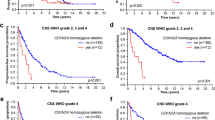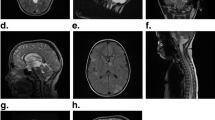Abstract
Introduction
Effective glioblastoma (GBM) treatment is limited by high invasiveness and heterogeneity. Current therapies target proliferating Glioma Stem Cell (GSC) subpopulations while sparing invading GSCs, which eventually engender tumor recurrence after treatment. Surface receptor CD97/ADRGE5 is associated with invasion and metastasis regulation in non-CNS cancers. Although CD97 expression level positively correlates with poor GBM patient prognosis, its role in this tumor is unclear.
Methods
Here, we examined CD97 function in primary patient-derived GSCs (pdGSCs) obtained from five GBM tumors, belonging to three major genetic subtypes. We compared endogenous CD97 levels in pdGSCs to the corresponding patient MRI’s radiographic invasion pattern aggressiveness. We manipulated CD97 levels in these pdGSCs by knockdown and overexpression and analyzed: (i) stem and subtype marker expression, (ii) in vitro invasive properties, and (iii) cell proliferation.
Results
Endogenous CD97 levels in pdGSCs positively correlated with radiographic invasion pattern aggressiveness on patient MRIs, and in vitro invasion rate. CD97 knockdown decreased pdGSC invasion rates in vitro, most markedly in mesenchymal subtype pdGSCs, as well as classical subtype pdGSCs. Invasion rates in vitro increased after CD97 overexpression predominately in proneural subtype pdGSCs. In the pdGSC line with the lowest endogenous CD97 level, CD97 overexpression increased the proliferation rate almost threefold.
Conclusions
For the first time in pdGSCs, we have shown that CD97 knockdown decreases and overexpression increases invasion rate in vitro. The effect of CD97 on invasion is pdGSC subtype-dependent. Future in vivo and mechanistic studies are needed for validation. Pharmacologic CD97 inhibitors should be identified, as they may potentially therapeutically diminish GBM invasion.





Similar content being viewed by others
Data availability
The data generated and analyzed in this study are provided in the text and in the figure, tables, and supplementary tables. Any additional data needed can be requested from the corresponding author.
References
Behnan J, Finocchiaro G, Hanna G (2019) The landscape of the mesenchymal signature in brain tumours. Brain 142:847–866. https://doi.org/10.1093/brain/awz044
Stupp R, Mason WP, van den Bent MJ, Weller M, Fisher B, Taphoorn MJ, Belanger K, Brandes AA, Marosi C, Bogdahn U, Curschmann J, Janzer RC, Ludwin SK, Gorlia T, Allgeier A, Lacombe D, Cairncross JG, Eisenhauer E, Mirimanoff RO, Organisation European, European Organisation for R, Treatment of Cancer Brain T, Radiotherapy G, National Cancer Institute of Canada Clinical Trials G (2005) Radiotherapy plus concomitant and adjuvant temozolomide for glioblastoma. New Engl J Med 352:987–996. https://doi.org/10.1056/NEJMoa043330
Safaee M, Clark AJ, Oh MC, Ivan ME, Bloch O, Kaur G, Sun MZ, Kim JM, Oh T, Berger MS, Parsa AT (2013) Overexpression of CD97 confers an invasive phenotype in glioblastoma cells and is associated with decreased survival of glioblastoma patients. PLoS ONE 8: https://doi.org/10.1371/journal.pone.0062765
Safaee M, Fakurnejad S, Bloch O, Clark AJ, Ivan ME, Sun MZ, Oh T, Phillips JJ, Parsa AT (2015) Proportional upregulation of CD97 isoforms in glioblastoma and glioblastoma-derived brain tumor initiating cells. PLoS ONE 10: https://doi.org/10.1371/journal.pone.0111532
He Z, Wu H, Jiao Y, Zheng J (2015) Expression and prognostic value of CD97 and its ligand CD55 in pancreatic cancer. Oncol Lett 9:793–797. https://doi.org/10.3892/ol.2014.2751
Ward Y, Lake R, Yin JJ, Heger CD, Raffeld M, Goldsmith PK, Merino M, Kelly K (2011) LPA receptor heterodimerizes with CD97 to amplify LPA-initiated RHO-dependent signaling and invasion in prostate cancer cells. Cancer Res 71:7301–7311. https://doi.org/10.1158/0008-5472.CAN-11-2381
Ward Y, Lake R, Martin PL, Killian K, Salerno P, Wang T, Meltzer P, Merino M, Cheng SY, Santoro M, Garcia-Rostan G, Kelly K (2013) CD97 amplifies LPA receptor signaling and promotes thyroid cancer progression in a mouse model. Oncogene 32:2726–2738. https://doi.org/10.1038/onc.2012.301
Liu D, Li C, Trojanowicz B, Li X, Shi D, Zhan C, Wang Z, Chen L (2016) CD97 promotion of gastric carcinoma lymphatic metastasis is exosome dependent. Gastric Cancer 19:754–766. https://doi.org/10.1007/s10120-015-0523-y
Yu OM, Benitez JA, Plouffe SW, Ryback D, Klein A, Smith J, Greenbaum J, Delatte B, Rao A, Guan KL, Furnari FB, Chaim OM, Miyamoto S, Brown JH (2018) YAP and MRTF-A, transcriptional co-activators of RhoA-mediated gene expression, are critical for glioblastoma tumorigenicity. Oncogene 37:5492–5507. https://doi.org/10.1038/s41388-018-0301-5
Wu V, Yeerna H, Nohata N, Chiou J, Harismendy O, Raimondi F, Inoue A, Russell RB, Tamayo P, Gutkind JS (2019) Illuminating the Onco-GPCRome: novel G protein-coupled receptor-driven oncocrine networks and targets for cancer immunotherapy. J Biol Chem 294:11062–11086. https://doi.org/10.1074/jbc.REV119.005601
Vizurraga A, Adhikari R, Yeung J, Yu M, Tall GG (2020) Mechanisms of adhesion G protein-coupled receptor activation. J Biol Chem 295:14065–14083. https://doi.org/10.1074/jbc.REV120.007423
Juneja J, Casey PJ (2009) Role of G12 proteins in oncogenesis and metastasis. Br J Pharmacol 158:32–40. https://doi.org/10.1111/j.1476-5381.2009.00180.x
Chidambaram A, Fillmore HL, Van Meter TE, Dumur CI, Broaddus WC (2012) Novel report of expression and function of CD97 in malignant gliomas: correlation with Wilms tumor 1 expression and glioma cell invasiveness. J Neurosurg 116:843–853. https://doi.org/10.3171/2011.11.JNS111455
Allen M, Bjerke M, Edlund H, Nelander S, Westermark B (2016) Origin of the U87MG glioma cell line: Good news and bad news. Sci Transl Med. https://doi.org/10.1126/scitranslmed.aaf6853
Pollard SM, Yoshikawa K, Clarke ID, Danovi D, Stricker S, Russell R, Bayani J, Head R, Lee M, Bernstein M, Squire JA, Smith A, Dirks P (2009) Glioma stem cell lines expanded in adherent culture have tumor-specific phenotypes and are suitable for chemical and genetic screens. Cell Stem Cell 4:568–580. https://doi.org/10.1016/j.stem.2009.03.014
Verhaak RG, Hoadley KA, Purdom E, Wang V, Qi Y, Wilkerson MD, Miller CR, Ding L, Golub T, Mesirov JP, Alexe G, Lawrence M, O’Kelly M, Tamayo P, Weir BA, Gabriel S, Winckler W, Gupta S, Jakkula L, Feiler HS, Hodgson JG, James CD, Sarkaria JN, Brennan C, Kahn A, Spellman PT, Wilson RK, Speed TP, Gray JW, Meyerson M, Getz G, Perou CM, Hayes DN, Cancer Genome Atlas Research N (2010) Integrated genomic analysis identifies clinically relevant subtypes of glioblastoma characterized by abnormalities in PDGFRA, IDH1, EGFR, and NF1. Cancer Cell 17:98–110. https://doi.org/10.1016/j.ccr.2009.12.020
Neftel C, Laffy J, Filbin MG, Hara T, Shore ME, Rahme GJ, Richman AR, Silverbush D, Shaw ML, Hebert CM, Dewitt J, Gritsch S, Perez EM, Gonzalez Castro LN, Lan X, Druck N, Rodman C, Dionne D, Kaplan A, Bertalan MS, Small J, Pelton K, Becker S, Bonal D, Nguyen QD, Servis RL, Fung JM, Mylvaganam R, Mayr L, Gojo J, Haberler C, Geyeregger R, Czech T, Slavc I, Nahed BV, Curry WT, Carter BS, Wakimoto H, Brastianos PK, Batchelor TT, Stemmer-Rachamimov A, Martinez-Lage M, Frosch MP, Stamenkovic I, Riggi N, Rheinbay E, Monje M, Rozenblatt-Rosen O, Cahill DP, Patel AP, Hunter T, Verma IM, Ligon KL, Louis DN, Regev A, Bernstein BE, Tirosh I, Suva ML (2019) An integrative model of cellular states, plasticity, and genetics for glioblastoma. Cell 178(835–849): https://doi.org/10.1016/j.cell.2019.06.024
Wolf KJ, Shukla P, Springer K, Lee S, Coombes JD, Choy CJ, Kenny SJ, Xu K, Kumar S (2020) A mode of cell adhesion and migration facilitated by CD44-dependent microtentacles. Proc Natl Acad Sci USA 117:11432–11443. https://doi.org/10.1073/pnas.1914294117
Bellail AC, Hunter SB, Brat DJ, Tan C, Van Meir EG (2004) Microregional extracellular matrix heterogeneity in brain modulates glioma cell invasion. Int J Biochem Cell Biol 36:1046–1069. https://doi.org/10.1016/j.biocel.2004.01.013
Novak U, Kaye AH (2000) Extracellular matrix and the brain: components and function. J Clin Neurosci 7:280–290. https://doi.org/10.1054/jocn.1999.0212
Yin Y, Xu X, Tang J, Zhang W, Zhangyuan G, Ji J, Deng L, Lu S, Zhuo H, Sun B (2018) CD97 promotes tumor aggressiveness through the traditional G Protein-coupled receptor-mediated signaling in hepatocellular carcinoma. Hepatology 68:1865–1878. https://doi.org/10.1002/hep.30068
Iglesias JM, Gumuzio J, Martin AG (2017) Linking pluripotency reprogramming and cancer. Stem Cells Transl Med 6:335–339. https://doi.org/10.5966/sctm.2015-0225
Han X, Fang X, Lou X, Hua D, Ding W, Foltz G, Hood L, Yuan Y, Lin B (2012) Silencing SOX2 induced mesenchymal-epithelial transition and its expression predicts liver and lymph node metastasis of CRC patients. PLoS ONE 7: https://doi.org/10.1371/journal.pone.0041335
Zhang S, Cui W (2014) Sox2, a key factor in the regulation of pluripotency and neural differentiation. World J Stem Cells 6:305–311. https://doi.org/10.4252/wjsc.v6.i3.305
Hilbig D, Dietrich N, Wandel E, Gonsior S, Sittig D, Hamann J, Aust G (2018) The interaction of CD97/ADGRE5 with beta-catenin in adherens junctions is lost during colorectal carcinogenesis. Front Oncol 8:182. https://doi.org/10.3389/fonc.2018.00182
Liu JK, Lubelski D, Schonberg DL, Wu Q, Hale JS, Flavahan WA, Mulkearns-Hubert EE, Man J, Hjelmeland AB, Yu J, Lathia JD, Rich JN (2014) Phage display discovery of novel molecular targets in glioblastoma-initiating cells. Cell Death Differ 21:1325–1339. https://doi.org/10.1038/cdd.2014.65
Gad AA, Balenga N (2020) The emerging role of adhesion GPCRs in cancer. ACS Pharmacol Transl Sci 3:29–42. https://doi.org/10.1021/acsptsci.9b00093
Funding
Dr. Daniel Eichberg and this work are supported by the Neurosurgery Research & Education Foundation (2021-22 NREF & StacheStrong Research Fellowship Grant on behalf of the AANS/CNS Section on Tumors). Dr. Daniel Eichberg is supported by training grant T32-CA-211034 from the National Cancer Institute. The content is solely the responsibility of the authors and does not necessarily represent the official views of the National Institutes of Health. Dr. Michael Ivan is funded by the Elsa U. Pardee Foundation Cancer Grant and the American Cancer Society Institutional Grant for this work.
Author information
Authors and Affiliations
Contributions
Conception and design: DGE, TIS, ALP, RJK, MEI. Experimentation, collection and assembly of data: DGE, TIS, ALP. Data analysis/interpretation DGE, TIS, ALP, RJK, MEI. Cytological examination of tumor tissues: DGE, TIS. Contributions to manuscript writing: DGE, TIS, MEI. Final approval of manuscript: All authors.
Corresponding author
Ethics declarations
Conflict of interest
Dr. Michael Ivan reports being a consultant to and receiving research funding from Medtronic and the NX Development Corporation.
Consent for publication
No individual patient data is reported in this study.
Ethical approval
University of Miami Institutional Review Board for human research (IRB #20190521). Both written and verbal informed preoperative consent were provided from all patients.
Informed consent
Informed consent was obtained.
Additional information
Publisher's Note
Springer Nature remains neutral with regard to jurisdictional claims in published maps and institutional affiliations.
Supplementary Information
Below is the link to the electronic supplementary material.
Rights and permissions
About this article
Cite this article
Eichberg, D.G., Slepak, T.I., Pascoini, A.L. et al. Genetic manipulation of adhesion GPCR CD97/ADGRE5 modulates invasion in patient-derived glioma stem cells. J Neurooncol 153, 383–391 (2021). https://doi.org/10.1007/s11060-021-03778-8
Received:
Accepted:
Published:
Issue Date:
DOI: https://doi.org/10.1007/s11060-021-03778-8




